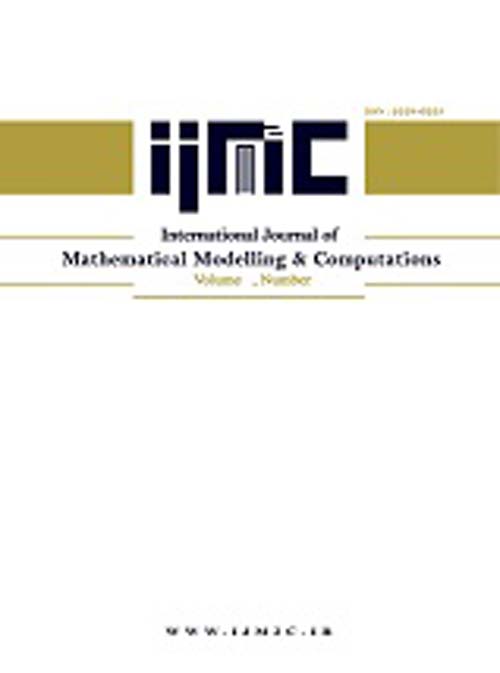فهرست مطالب

مجله بین المللی محاسبات و مدل سازی ریاضی
سال نهم شماره 2 (Spring 2019)
- تاریخ انتشار: 1398/03/11
- تعداد عناوین: 6
-
Pages 83-100
In this paper, an SIR epidemic model with an infectious period and a non-linear Beddington-DeAngelis type incidence rate function is considered. The dynamics of this model depend on the reproduction number R0. Accurately, if R0 < 1, we show the global asymptotic stability of the disease-free equilibrium by analyzing the corresponding characteristic equation and using comparison arguments. In contrast, if R0 > 1, we see that the disease-free equilibrium is unstable and the endemic equilibrium is permanent and locally asymptotically stable and we give sufficient conditions for the global asymptotic stability of the endemic equilibrium.
Keywords: SIR epidemic model, infectious period, characteristic equation, comparison arguments, permanence, Global stability, Beddington-DeAngelis incidence -
Pages 101-111In this paper, we prove the existence and uniqueness of fixed points for cyclic (α,β)-admissible type F-contraction and F−weak contraction under the setting of modular spaces, where the modular is convex and satisfying the ∆2-condition. Later, we prove some periodic point results for self-mappings on a modular space. We also give some examples to support our results.Keywords: modular space, fixed point, F-contraction, Cyclic (α, β)-admissible mapping
-
Pages 113-122In this paper, a meta-heuristic method, the Bat Algorithm, based on the echolocation behavior of bats is used to determine the optimum service rate of a queue problem. A finite buffer M/M/1 queue with N policy, multiple working vacations and Bernoulli schedule vacation interruption is considered. Under the two customers' impatient situations, balking and reneging, the queue is studied using the matrix geometric method. Simulations show that the proposed algorithm seems much superior to other algorithms.Keywords: Bat algorithm, Working vacations, balking, Reneging, Queue
-
Pages 123-147In this study we model the daily rainfall occurrence using Markov Chain Analogue Yearmodel (MCAYM) and the intensity or amount of daily rainfall using three different probability distributions; gamma, exponential and mixed exponential distributions. Combining the occurrence and intensity model we obtain Markov Chain Analogue Year gamma model (MCAYGM), Markov Chain Analogue Year exponential model (MCAYEM) and Markov Chain Analogue Year mixed exponential model (MCAYMEM). The models are assessed using twenty nine-years(1987-2015) of historical records of daily rainfall data taken from three different locations which are obtained from Ethiopian National Meteorology Agency (ENMA). Both maximum likelihood and least square techniques are used in the estimation of model parameter. The results indicate that all the three model are suitable for the simulation of precipitation process. In order to assess their performance we apply both qualitative (graphical demonstration) and quantitative techniques. In the quantitative, the performance of the three models; MCAYEM, MCAYGM and MCAYMEM are measured using mean absolute error(MAE) and have mean absolute error of 0.45mm, 0.57 mm and 0.42mm respectively for kiremet(June to September) rainfall which is the long rainy season in Ethiopia. These accuracy is mainly because of the new component that is Analogue Year (AY) used in the modeling of frequency of daily rainfall included in the Markov chain (MC) process. Based on these model we obtain an option price for Teff crop for different months. The result shows an excellent accuracy with only maximum absolute error of 0.54 currency.Keywords: Analogue year, exponential distribution, gamma distribution, Markov chain, option price, Teff
-
Pages 149-154In this article we have proposed an accurate finite difference method for approximate numerical solution of second order boundary value problem with Dirichlet boundary conditions. There are numerous numerical methods for solving these boundary value problems. Some these methods are more efficient and accurate than others with some advantages and disadvantages. The results in experiment on model problems show an improved and good approximation to the solution of considered problems.Keywords: Boundary Value Problem, Dirichlet boundary condition, Finite difference method, Non-linear equation, Unconventional difference method
-
Initial Value Problems for Fourth-Order Fuzzy Differential Equations by Fuzzy Laplace TransformPages 155-164This paper is on the solutions of fuzzy initial value problems for fourth-order fuzzy differential equations with positive and negative fuzzy coefficients by fuzzy Laplace transform. Examples are solved. Conclusions are given.Keywords: fuzzy differential equation, Fuzzy Laplace Transform, Positive fuzzy number, Negative fuzzy number

